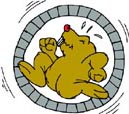 Q: Is there such a thing as memory fluid? And can shapes affect your thoughts? Or can any other things affect your thoughts? Me and a friend are doing a science fair project and we are testing hamster memory. We will make three different mazes and put the hamster in, and see how many times it takes for it to remember the route. She suggested varying the materials, but I said I don’t think that’ll affect it, so let’s use shapes instead. But do the shapes or the materials (or both) affect your thoughts more? – Johnny
Q: Is there such a thing as memory fluid? And can shapes affect your thoughts? Or can any other things affect your thoughts? Me and a friend are doing a science fair project and we are testing hamster memory. We will make three different mazes and put the hamster in, and see how many times it takes for it to remember the route. She suggested varying the materials, but I said I don’t think that’ll affect it, so let’s use shapes instead. But do the shapes or the materials (or both) affect your thoughts more? – Johnny
Dear Johnny,

What’s a good kid like you doing on a website like this?
You can make a good case that any creature with a reasonably advanced visual system is affected by shapes in the environment, along with light and movement. That’s the whole point of having eyeballs. (Some folks will want to point out that there is a difference between shapes and symbols. Agreed, but let’s keep things simple.)
There’s a good deal of research out there on animal shape recognition, including a curious study in which N.S. Sutherland (1969) compared the discrimination abilities of a rat, a goldfish, and an octopus. The rat took most of the trophies that day, but the goldfish performed swimmingly and the octopus didn’t suck.
Old studies are fun to look at, but your question raised an even more pressing issue in my mind: How can I use animal shape recognition to my own advantage by teaching my dog to read?
I called my good friend Ana Melara, the World’s Most Amazing Dog Trainer and Behavior Counselor. She wants to assure you, Johnny, that not only can animals recognize shapes, but dogs can even respond to very complex shapes, including written words such as “come” and “sit.”
Ana gave me a few pointers, and soon I had Hachi the Iron Dog responding to different shapes. In the span of ten brief training sessions spread out over a day, she learned that responding to a star, instead of a circle, earned her a treat.
Each training session consisted of 3-5 trials in which she could choose to move toward one shape or the other. When she moved toward the star, she got a cookie; when she moved toward the circle, she got nothing. I randomized the location of the shapes and made sure she ended each session with a success so she wouldn’t become frustrated and confused. She’s now sleeping in the corner, her belly full of treats.
A couple of things to keep in mind, Johnny. First, my interaction with Hachi wasn’t an experiment, it was a training session. Your teacher can help you with the difference between the two.
Secondly, a dog that can “read” doesn’t have much to do with your question about shape versus texture. That doesn’t matter. You already have everything you need for your science fair: a teacher to help you set up the experiment correctly, willing hamsters, and a good question. It’s the quality of the experiment that counts, not the answer.
As for “memory fluid,” I’ve not heard of it. Maybe you’re thinking of “fluid intelligence” which is psychologist shorthand for the ability to think on your feet – a skill at which I’m sure you excel.
-IS
References:

Sutherland, N.S. (1969). Shape discrimination in rat, octopus, and goldfish: a comparative study. Journal of Comparative and Physiological Psychology, 67(2), 160-176.
Ana Melara, the World’s Most Amazing Dog Trainer and Behavior Counselor, can be reached through her website, http://www.trainingwithgrace.com.
